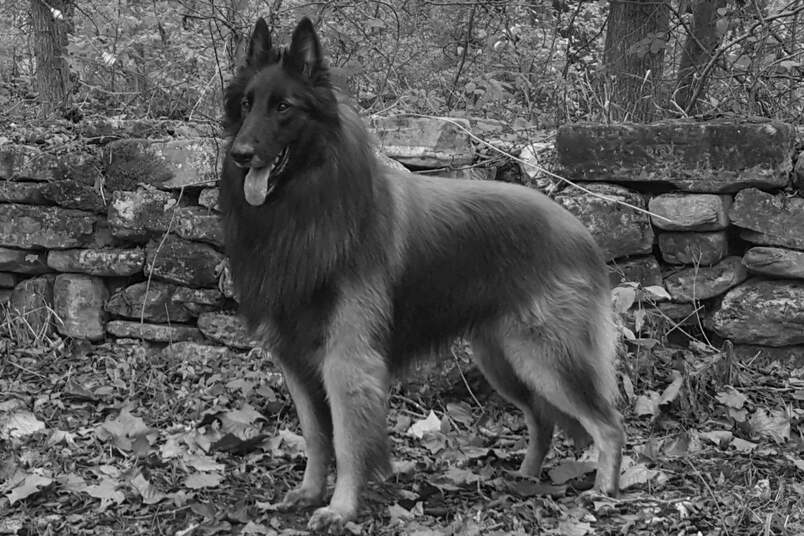
Janina Laurin | Chateau Blanc Kennels
Interview with Herding Group Breeder Janina Laurin – I live in Connecticut. I am a second generation dog owner/breeder/judge, so I always
Home » Meet The Breeds » Belgian Tervuren
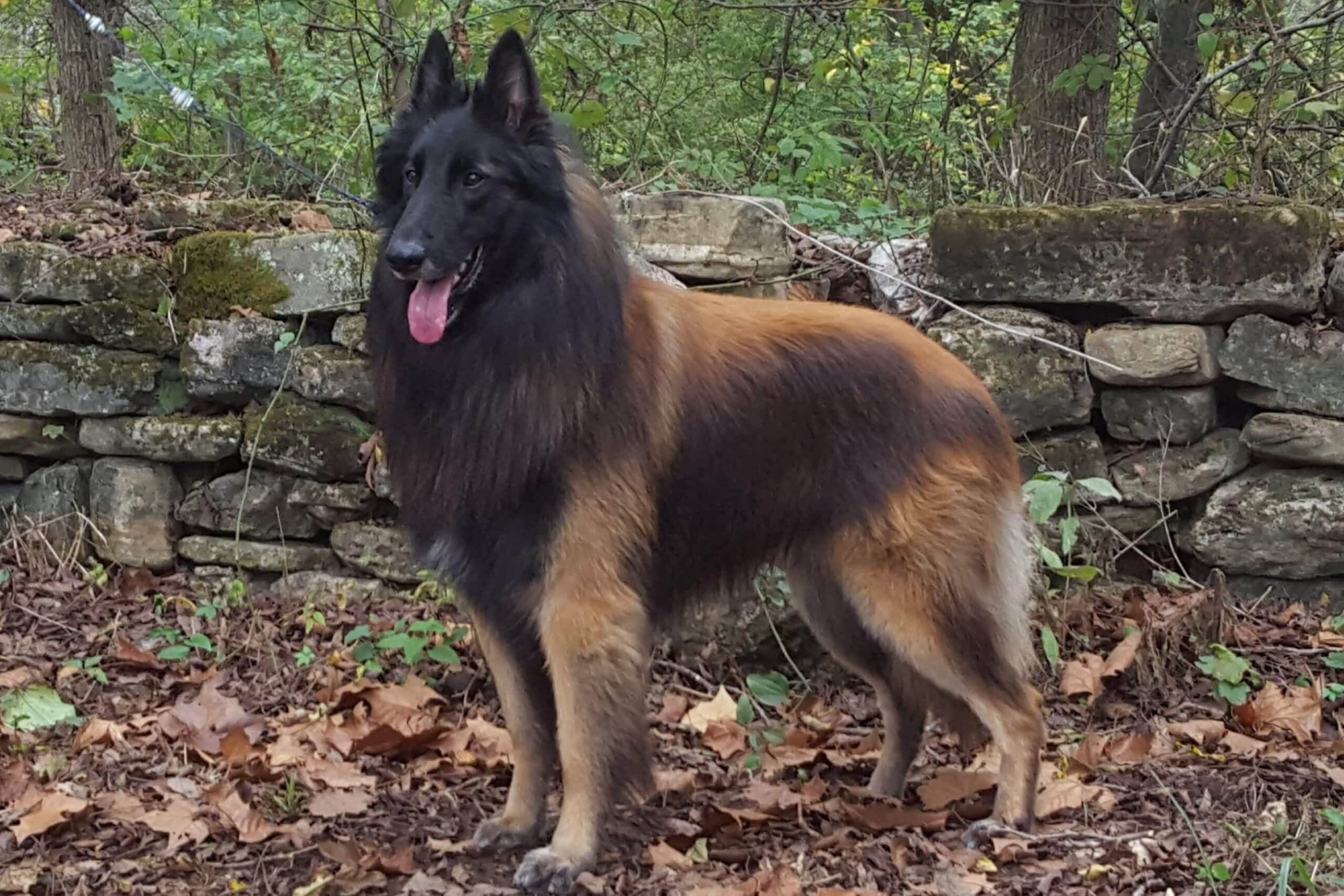
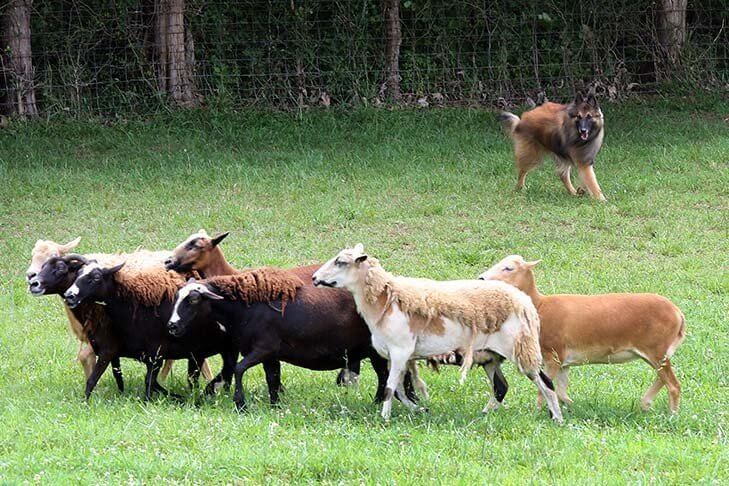
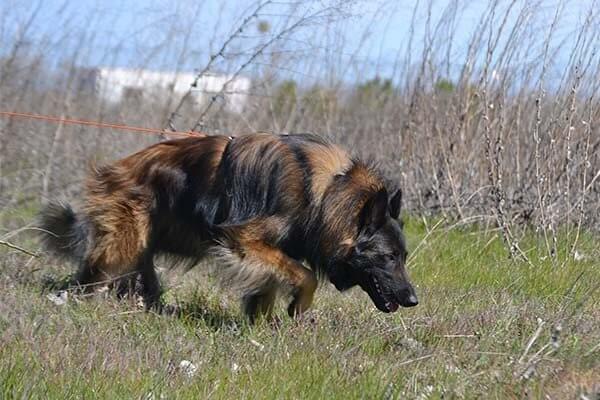
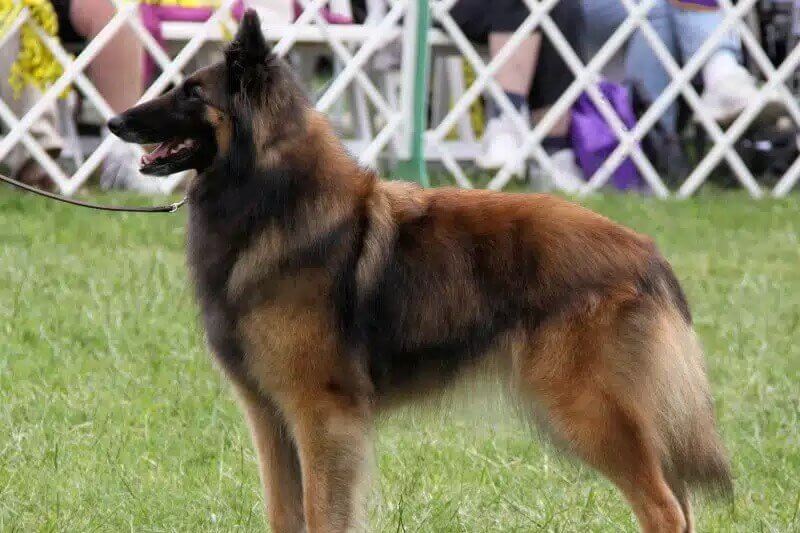
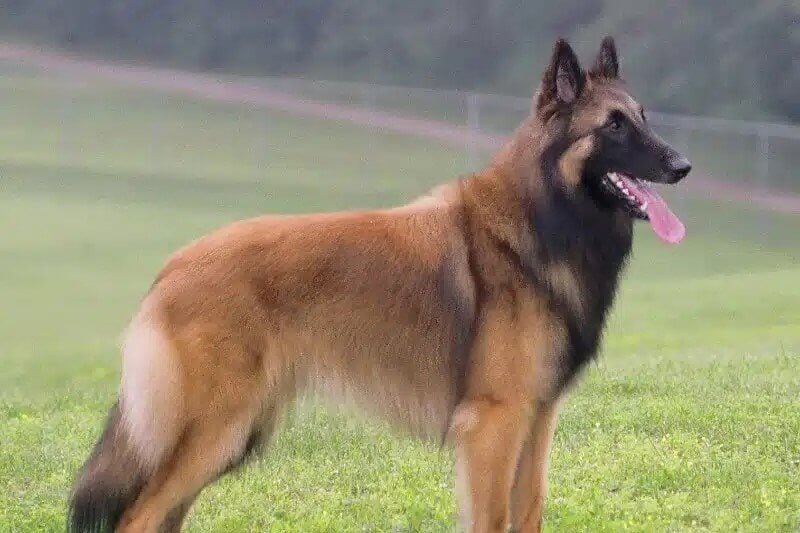
The Belgian Tervuren, often referred to simply as the Tervuren or “Terv,” is one of four Belgian sheepdog breeds/varieties that is distinguished by its long, flowing coat and dynamic presence. Known for its versatility, the Tervuren excels in a wide variety of roles, from a reliable working dog to a much loved companion in the home.
Herding
22 – 26 Inches
45 – 75 Pounds
12 – 14 Years
| Country of Origin | Belgium |
|---|---|
| Bred For | Herding, Guarding, Companionship |
| Known For | Intelligence, Sensitivity, Loyalty, Elegant Appearance, Proud Carriage |
| Popularity | Moderate |
| Temperament | Alert, Intelligent, Courageous, Protective |
| Activities | Herding, Running, Hiking, Conformation Shows, Dog Sports |
The Belgian Tervuren, one of the four varieties of Belgian Shepherd, boasts a rich and storied history. Originating from the Tervuren region of Belgium, hence its name, this breed/variety has been a cherished herding companion for centuries.
The Tervuren, like its cousins (the Belgian Laekenois, Belgian Malinois, and Belgian Sheepdog), was primarily developed as a working dog, designed to herd livestock and protect the animals from potential threats. Given the varying regions of Belgium and the specific needs of local farmers, the dogs naturally diverged in coat type and color, eventually leading to the distinct breeds/varieties that are recognized by registries today.
While the primary function of the Belgian Tervuren was herding, the dog’s intelligence, loyalty, and versatility soon saw it serving in other roles, such as police work, search and rescue operations, and even as messengers and draft animals during wartime. World Wars I and II saw a decline in the breed’s population due to the devastations of war, but dedicated breed enthusiasts worked diligently to revive and preserve it during the mid-20th century.
Official recognition of the Belgian Tervuren varies across different kennel clubs. The American Kennel Club (AKC) officially recognized the Belgian Tervuren as a distinct breed, separate from the other Belgian Shepherds, in 1959. On the other hand, the Fédération Cynologique Internationale (FCI) recognizes all the four Belgian Shepherds as variants of a single breed. The Royal Kennel Club (UK) recognizes the Belgian Tervuren under the collective name of “Belgian Shepherd Dog,” but distinguishes the dogs by coat type and color.
Over time, the Tervuren has also made its mark in the Conformation show ring, not just as a working dog. With its elegant appearance, intelligence, and agility, the breed soon gained popularity in many countries, including the United States, where it has developed a devoted following.
Today, the Belgian Tervuren stands as a testament to the dedication of breed enthusiasts. Its enduring qualities of intelligence, loyalty, and versatility, have made it a favorite of many both at home and in the pasture.
Adult male Belgian Tervuren typically stand between 24 and 26 inches tall at the shoulder, while mature females tend to be slightly smaller, ranging from 22 to 24 inches in height.
As for weight, males generally weigh between 55 and 75 pounds, with females usually weighing in the 45- to 60-pound range.
The Belgian Tervuren boasts a well-proportioned and robust body. The dog’s length, measured from the point of the shoulder to the point of the buttocks, is roughly equal to the height at the withers, giving the Terv a nearly square profile. This breed/variety has strong bone, yet it doesn’t appear heavy. Substance and elegance are both vital characteristics of the Tervuren, thus creating a harmonious balance of strength and agility.
Texture: The Belgian Tervuren boasts a double coat, designed to shield these dogs in various weather conditions. The outer coat is straight, abundant, and of medium length, aligning naturally with the body. The texture is neither silky nor rough. Instead, the texture lies somewhere in between, offering protection as well as creating the breed’s signature elegance. The undercoat, on the other hand, is dense and soft, ensuring insulation against harsh weather.
| Standard Color | |
|---|---|
| Fawn & Black | ee |
| Mahogany & Black | ee |
| Brindle | ee |
| Gray & Black | ee |
| Gray & Black | ee |
| Black | ee |
| Cream & Black | ee |
| Fawn & Liver | ee |
| Mahogany & Liver | ee |
| Standard Marking | |
|---|---|
| White Markings | ee |
| Black Mask | ee |
| Black Markings | ee |
| Black Points | ee |
A Note About Color: The coat of the Belgian Tervuren consists of double-pigmented hairs that are black-tipped, giving an overlay appearance. This blackening is most pronounced on the shoulders, back, and ribs; it does not appear in patches. The ears are black, as is the face where it forms a mask. The coat’s color on the underside of the body, breeches, and tail may be cream, gray, or light beige. White is acceptable only on the chest and/or the tips of the toes. Otherwise, white markings are a serious offense, as are solid black- or solid liver-colored dogs.
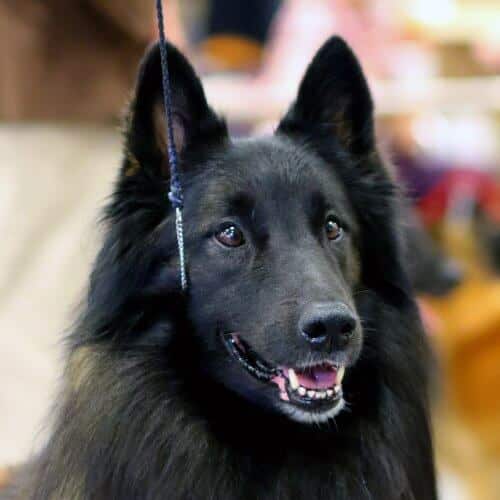
The Belgian Tervuren’s tail is a continuation of the dog’s elegant silhouette, further accentuating the dog’s graceful presence and agile demeanor.
The tail of the Tervuren is strong at its base and gradually tapers towards the end. When the dog is at rest, the tail hangs down and reaches at least to the hock. The tip may curve slightly upward, but it does not form a hook. In action, or when the dog is excited, the tail is raised but should never curl over the back.
The tail is well-covered with thick, long hair, forming a plume. This luxurious fringe is not only a sight to behold, it also reflects the breed’s adaptability to various weather conditions, as it provides an additional layer of protection against the elements.
It is worth noting that the Belgian Tervuren’s tail is never docked, thus allowing it to express a full range of emotions, from alertness to relaxation. The natural tail further contributes to the dog’s natural beauty.
Choosing to welcome a Belgian Tervuren into the home is a rewarding experience, but like all breeds and mixed breeds, the Terv has its own unique requirements and characteristics. Potential owners should be aware of the breed’s specific needs, temperament, and health considerations before commiting to the responsibilities that come with ownership.
The Belgian Tervuren is generally a healthy and robust breed/variety, one that is blessed with a long lineage of working dogs that have been bred for function as well as form.
Lifespan: A well-cared-for Belgian Tervuren has an average lifespan of 12 to 14 years, although many have been known to live even longer.
The Belgian Tervuren, while generally a robust dog, can have certain health issues that prospective and current owners should be vigilant about. Some of the more common concerns include:
While these are the most common concerns, it’s essential to note that not every Belgian Tervuren will be diagnosed with any or all of these conditions. Regular veterinary check-ups, proper nutrition, and a well-maintained environment play a crucial role in a Terv’s overall health.
The Belgian Tervuren is renowned not just for its physical allure, but also for its captivating personality. A dog imbued with both intelligence and a strong work ethic, the Terv is versatile and adaptable. However, these traits also mean that they have specific needs in terms of interaction and stimulation.
Tervuren, while incredibly loyal, forming deep bonds with their families, presents a unique set of challenges due to this dog’s intelligence and high energy levels. For novice dog owners, it’s essential to be prepared to invest time into training and to maintain consistent boundaries that will harness the breed’s full potential and ensure a harmonious relationship in the home.
When considering the sensitivity level of the Tervuren, one can note that this dog is deeply intuitive. Tervs are attuned to the emotions of their family members and will often act as mirrors, reflecting the mood of their environment. This makes them excellent companions, but it also means they will thrive best in a stable, loving environment.
Leaving a Tervuren alone for extended periods is not recommended. These dogs are social animals and benefit from consistent interaction and activity. Extended isolation can lead to anxiety or unwanted behaviors.
When it comes to socializing with other dogs, Tervuren generally fares well, especially if introduced appropriately. However, early socialization is key to ensure they’re comfortable and confident around other canines.
Their disposition towards young children is typically gentle and protective. However, like with all breeds and mixed breeds, it’s crucial to teach children how to approach and interact with the dog, ensuring a harmonious relationship.
In terms of being dog-friendly, the Tervuren is generally accepting of other canines, especially when raised together or when they’ve undergone proper introductions.
Lastly, when it comes to strangers, the Belgian Tervuren is naturally protective and might be reserved initially. Proper introductions and early socialization can help them to discern between genuine threats and benign visitors.
Feeding the Belgian Tervuren properly is vital to support its active lifestyle and maintain its radiant coat. These dogs thrive on a balanced diet tailored to their age, size, and activity level.
For a Belgian Tervuren puppy, it’s crucial to provide a diet specifically formulated for large breed puppies. This helps in promoting steady growth and preventing issues like hip dysplasia in the future. Puppies typically require more frequent meals, often divided into three or four portions throughout the day.
Once the Tervuren transitions into adulthood, the dietary needs will change. An adult Belgian Tervuren, depending on its activity level, may require about 2 to 3 cups of high-quality dog food daily. This amount should be divided into two meals to promote better digestion and to prevent the risk of bloat, a condition to which large breeds can be susceptible.
It’s worth noting that the exact amount of food may vary based on the dog’s weight, metabolism, and daily activities. Therefore, regular consultation with a veterinarian or a pet nutritionist is recommended to determine an optimal feeding chart and for adjusting portions as necessary.
For those Tervuren involved in high-intensity activities or dog sports, their calorie intake might need to be increased. It’s essential to monitor their weight and condition, adjusting the food quantity to be sure they remain lean and fit, rather than overweight.
In all cases, access to fresh and clean water is paramount. Regularly checking and refilling the water dish guarantees that the Belgian Tervuren remains hydrated, especially after periods of rigorous activity.
The Belgian Tervuren is recognized for its keen intellect and eagerness to work, making it both a joy and a challenge to train. With a heritage deeply rooted in herding, this breed brings a high level of enthusiasm and energy to tasks, requiring a handler who can match its vigor.
Ease of training is one of the Belgian Tervuren’s strong suits, but it’s not to be confused with simplicity. The intelligence of this dog means it catches on quickly, but it can also easily pick up bad habits if not correctly guided. Consistency, positive reinforcement, and early socialization are the cornerstones of successful training for this breed/variety.
While they are alert and attentive, Belgian Tervuren do have a tendency to bark, especially when guarding or herding. Proper training from a young age can help to control excessive barking, ensuring they bark for a reason and not just out of habit.
Regarding intelligence, the Belgian Tervuren ranks highly among dog breeds. Tervs thrive on mental stimulation, and training sessions often double as brain workouts for them. Puzzle toys and advanced obedience classes can keep their minds sharp and engaged.
Wanderlust potential is relatively low for the Belgian Tervuren when compared to some breeds. However, given their herding background, Tervs might chase after moving objects, including cars or bicycles. Proper recall training and a secure fence are essential to keep them safe at all times.
Lastly, the prey drive or predation instinct is inherent in many herding breeds, including the Belgian Tervuren. While these dogs might not necessarily want to harm smaller animals, their instinct to chase can be strong. Early training and socialization can help to manage this instinct, ensuring they can coexist peacefully with other household pets.
Meeting the exercise needs of the Belgian Tervuren is integral to maintaining the dog’s physical and mental well-being. Bred originally for herding, this breed/variety possesses a commendable blend of stamina and agility.
| Energy Level | High |
|---|---|
| Exercise Requirements | 1 Hour/Day (Minimum), Daily Walks, Vigorous Running, Regular Exercise, Playing with Another Dog, Mental Stimulation |
The exercise regimen for a Belgian Tervuren should be multifaceted. Tervs don’t just require physical exertion, they also need mental stimulation. A simple walk around the block is insufficient for these dynamic dogs. Extended play sessions, jogging, hiking, and regular trips to a safe and secure dog park can help to channel the Terv’s energy productively.
In terms of energy level, the Belgian Tervuren is on the higher end of the spectrum. Without the proper outlets for their energy, they can become restless or even develop behavioral issues. As such, it’s crucial for potential owners to recognize and commit to the dog’s exercise needs.
The intensity of their exercise sessions should be relatively high. Incorporating training sessions, agility courses, or fetch can ensure they’re fully engaged both mentally and physically. It’s worth noting that exercise isn’t just about expending energy; it’s also an opportunity for Belgian Tervuren to bond with their owners.
Playfulness is another intrinsic trait of the Tervuren. This dog revels in interactive games and thrives in environments where it can engage in activities with their human counterparts. Whether it’s a game of tug-of-war or frisbee, the Terv is always an eager participant.
However, while ensuring they get ample exercise, it’s essential to monitor Belgian Tervuren for signs of exhaustion or overexertion, especially in extreme weather conditions.
The Belgian Tervuren is as captivating in its grooming needs as it is majestic in its appearance. With a thick double coat that gleams with health, maintaining its condition requires commitment and regular attention.
| Coat Type | Long, Straight, Well Fitting, Abundant |
|---|---|
| Grooming Requirements | Weekly Brushing, Occasional Bathing, Routine Ear Cleaning, Periodic Nail Trimming, Regular Tooth Brushing |
The Belgian Tervuren’s grooming is somewhat demanding due to its double coat that experiences seasonal shedding, especially in the spring and fall. These periods call for increased grooming sessions to handle the abundant hair and to avoid matting. Regular brushing, at least a couple of times a week with a pin brush or slicker brush, is essential to eliminate loose hair and for distributing the coat’s natural oils. Additionally, periodic baths will ensure the Terv’s coat remains clean and shines with vitality.
When discussing the amount of shedding, it’s safe to say that the Belgian Tervuren is not a light shedder. Potential owners should be prepared for a fair amount of hair around the house, especially during the shedding seasons. Investing in a good vacuum cleaner and having lint rollers on hand can be beneficial.
Beyond just the coat, other grooming essentials include regular nail trimming, ear cleaning to prevent infections, and dental care to ensure optimal oral health.
The experience of sharing a home with a Belgian Tervuren is both enriching and demanding. This dog’s intelligence, loyalty, and active nature shape the daily life of its families in many ways.
When considering apartment living, while the Belgian Tervuren is adaptable, the confined space of an apartment might not always be ideal for such an active breed. Tervs benefit from having a spacious yard where they can expend their energy and play. However, if ample exercise and engagement are provided, they can adjust to apartment life. Still, potential owners should be prepared to spend significant time outdoors with their Tervuren to meet their exercise requirements.
The Belgian Tervuren fares well in cold weather, given its thick double coat. This coat acts as insulation against colder temperatures, making these dogs more tolerant of chilly conditions. On the flip side, in hot weather, Tervs can be more susceptible to overheating. It’s essential to provide them with shade, fresh water, and limit their physical activities during peak hours of heat or humidity.
The allure of a Belgian Tervuren puppy is undeniable. With its fluffy coat and inquisitive eyes, these pups are guaranteed to captivate hearts instantly. However, behind that adorable facade is a bundle of energy and intelligence that requires nurturing guidance to mature into a well-adjusted adult.
From the moment they are brought home, Belgian Tervuren puppies demand attention, care, and consistent training. Their sharp minds are eager to learn, making early socialization and obedience training crucial. Introducing them to various environments, people, and other animals can shape their temperament and prevent undesired behaviors in the future.
Feeding Tervuren puppies a balanced diet is paramount. Puppy-specific formulas that cater to their growth needs are recommended. It’s also important to monitor their food intake and make adjustments based on their activity levels, ensuring they maintain a healthy weight. Overfeeding during these formative months can lead to obesity and other health issues.
As with any puppy, a Belgian Tervuren’s teething phase can be challenging. Offering chew toys will help to alleviate their discomfort and protect household items from their gnawing curiosity.
Establishing a routine early on – for feeding, potty breaks, playtime, and rest – can help the puppy feel secure and aid in smoother housebreaking.
Lastly, regular vet check-ups during the puppy phase will ensure the Belgian Tervuren puppy is on track with vaccinations and general health, setting a foundation for a long and happy life.
The Belgian Tervuren is not just a beautiful dog, it is also a versatile athlete, known for its intelligence, agility, and drive. These characteristics make the breed a perfect fit for various activities and dog sports.
The Belgian Tervuren’s versatility makes it one of the most well-rounded breeds in the world of dog sports. Whether they’re showing off their beauty in the Conformation ring or herding sheep in a field, these dogs bring dedication and enthusiasm to every task they undertake.
The Belgian Tervuren is recognized by the world’s leading registries and kennel organizations, which categorize the breed into a specific Group based on its unique characteristics. This breed is recognized worldwide under the following Group designations:
| Organization | Group Designation |
|---|---|
| AKC (American Kennel Club) | Herding |
| UKC (United Kennel Club) | Herding Dog |
| CKC (Canadian Kennel Club) | Herding |
| ANKC (Australian National Kennel Council) | Working |
| RKC (The Royal Kennel Club) | Pastoral |
| FCI (Fédération Cynologique Internationale) | Group 1: Sheepdogs and Cattledogs Section 1: Sheepdogs |
The ideal Belgian Tervuren is described by a Breed Standard that is approved by each of the world’s leading registries and kennel organizations. The Breed Standards for this breed may be found in the following links:
| Organization | Breed Standard |
|---|---|
| American Kennel Club | AKC Belgian Tervuren Breed Standard |
| United Kennel Club | UKC Belgian Tervuren Breed Standard |
| Canadian Kennel Club | CKC Belgian Tervuren Breed Standard |
| Australian National Kennel Council | ANKC Belgian Tervuren Breed Standard |
| The Royal Kennel Club | RKC Belgian Tervuren Breed Standard |
| Fédération Cynologique Internationale | FCI Belgian Tervuren Breed Standard |
Being part of a dedicated community can be invaluable for Belgian Tervuren enthusiasts, breeders, and owners. Breed clubs often provide resources, educational materials, events, and support to those who share a passion for the Terv.
In the United States, the American Belgian Tervuren Club (ABTC) stands out as a prominent organization. Established in the 1950s, the ABTC serves as the official parent club for the Belgian Tervuren under the auspices of the AKC. The club is deeply committed to the welfare and promotion of the breed, providing a platform for events, educational resources, and overall support for its members.
In Canada, the Belgian Shepherd Dog Club of Canada (BSDCC) has taken up the mantle for not just the Tervuren but all four Belgian Shepherd varieties. This inclusive approach allows the club to cater to a broader audience, emphasizing responsible breeding and showcasing the diverse skills of the Belgian breeds.
In the United Kingdom, the Belgian Shepherd Dog Association of Great Britain stands as a testament to the breed’s enduring popularity and significance. Having been active since the early 20th century, this association encompasses all Belgian Shepherd varieties, emphasizing the breed’s versatility from show rings to working trials.
For anyone who is passionate about the Belgian Tervuren, these clubs offer a gateway into a community of fellow enthusiasts, providing invaluable resources, opportunities for engagement, and a shared love for this remarkable and hardworking herder.
The beauty and grace of the Belgian Tervuren often lead to its admiration, but like all breeds, there are instances where these dogs may need a second chance at finding a loving home. This is where rescue groups play an invaluable role.
In the United States, numerous rescue groups are affiliated with the American Belgian Tervuren Club (ABTC). These organizations work diligently to provide care and support for Tervurens that have been abandoned, mistreated, or surrendered. Their mission is to ensure that each dog finds a suitable forever home where they will be cherished and cared for.
Canada, too, sees its fair share of Tervurens in need. Affiliates of the Belgian Shepherd Dog Club of Canada often have rescue arms dedicated to the breed, ensuring the dogs in need receive the specialized attention and care they require.
In the United Kingdom, while specific Belgian Tervuren rescue groups might be uncommon, the Belgian Shepherd Dog Association of Great Britain frequently steps in. This group and its volunteers will assist in providing care for any Tervuren, or their Belgian Shepherd counterparts, who finds itself in need of rehabilitation and rehoming.
Belgian Tervuren can make excellent pets for the right households. They are known for their intelligence, loyalty, and deep bond with their families. However, they do require consistent training, socialization, and ample physical and mental stimulation, making them better suited for active households or those familiar with the needs of working breeds.
Yes, Belgian Tervuren shed. They have a double coat that sheds throughout the year, with heavier shedding typically occurring during the spring and fall seasons. Regular grooming can help to manage the shedding and keep their coats healthy.
Belgian Tervuren can be wonderful family dogs, particularly when socialized from a young age. They tend to form strong bonds with all family members and can be protective of them. As with all dogs, interactions with younger children should always be supervised, and children should be taught to approach and handle this dog respectfully.
No, Belgian Tervuren are not considered hypoallergenic. They shed and, like all breeds and mixed breeds, produce dander, which can be a common allergen for many people. To ensure no allergic reactions, prospective owners with allergies should spend time around a Terv before deciding to welcome one home.
Yes, Belgian Tervuren can be effective guard dogs. Their natural protective instincts, combined with their loyalty to their family, make them wary of strangers and intruders. Their sharp senses and alertness also mean they are quick to notify their owners of any unusual activities.
Belgian Tervuren are primarily known for their herding capabilities, being one of the four Belgian Shepherd varieties developed for this purpose. They are also recognized for their striking appearance, intelligence, and versatility, having been used in various roles ranging from police work to therapy work, and even show dog competitions.
Belgian Tervuren are known to be vocal, especially when they perceive something unusual or feel the need to alert their families. Their herding background and protective nature can make them more aware of their surroundings, so proper training and socialization can help to manage excessive barking.
It’s not ideal to regularly leave a Belgian Tervuren alone for extended periods. This dog thrives on human interaction, physical activity, and mental stimulation. Extended isolation can lead to feelings of loneliness, anxiety, or the development of unwanted behaviors. If left alone, it’s crucial to ensure the Terv has ample toys and activities to keep it occupied, and arrangements should be made for regular exercise or human interaction throughout the day.

Interview with Herding Group Breeder Janina Laurin – I live in Connecticut. I am a second generation dog owner/breeder/judge, so I always
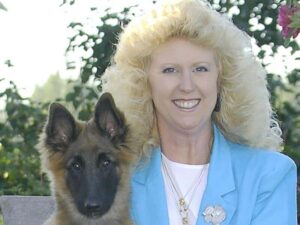
Belgian Tervuren breeder Michelle Edling discusses breed, challenges, and positive changes in the dog show community.
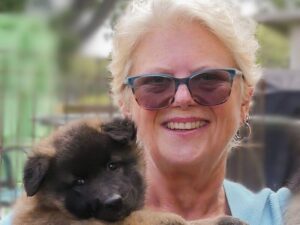
Belgian Tervuren breeder Alleyne Dickens discusses breed, challenges, and positive changes in the dog show community.
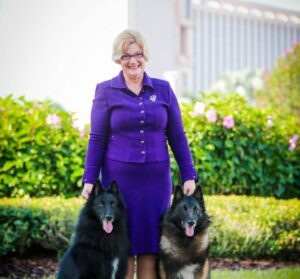
Interview with Herding Group Breeder Karyn Cowdrey – I live in Bellingham, Washington. I have been in dogs for 55 years. I have been a
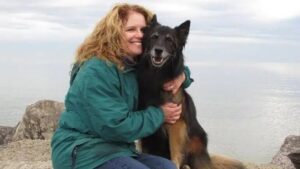
Insights from respected Belgian Tervuren breeders, exploring the breed’s unique characteristics, coat colors, and remarkable versatility.
The best way to ensure a long and happy relationship with a purebred dog is to purchase one from a responsible breeder. Not sure where to begin?
Contact the National Parent Club’s Breeder Referral Program, which is listed on the AKC Breeder Referral Contacts page.
